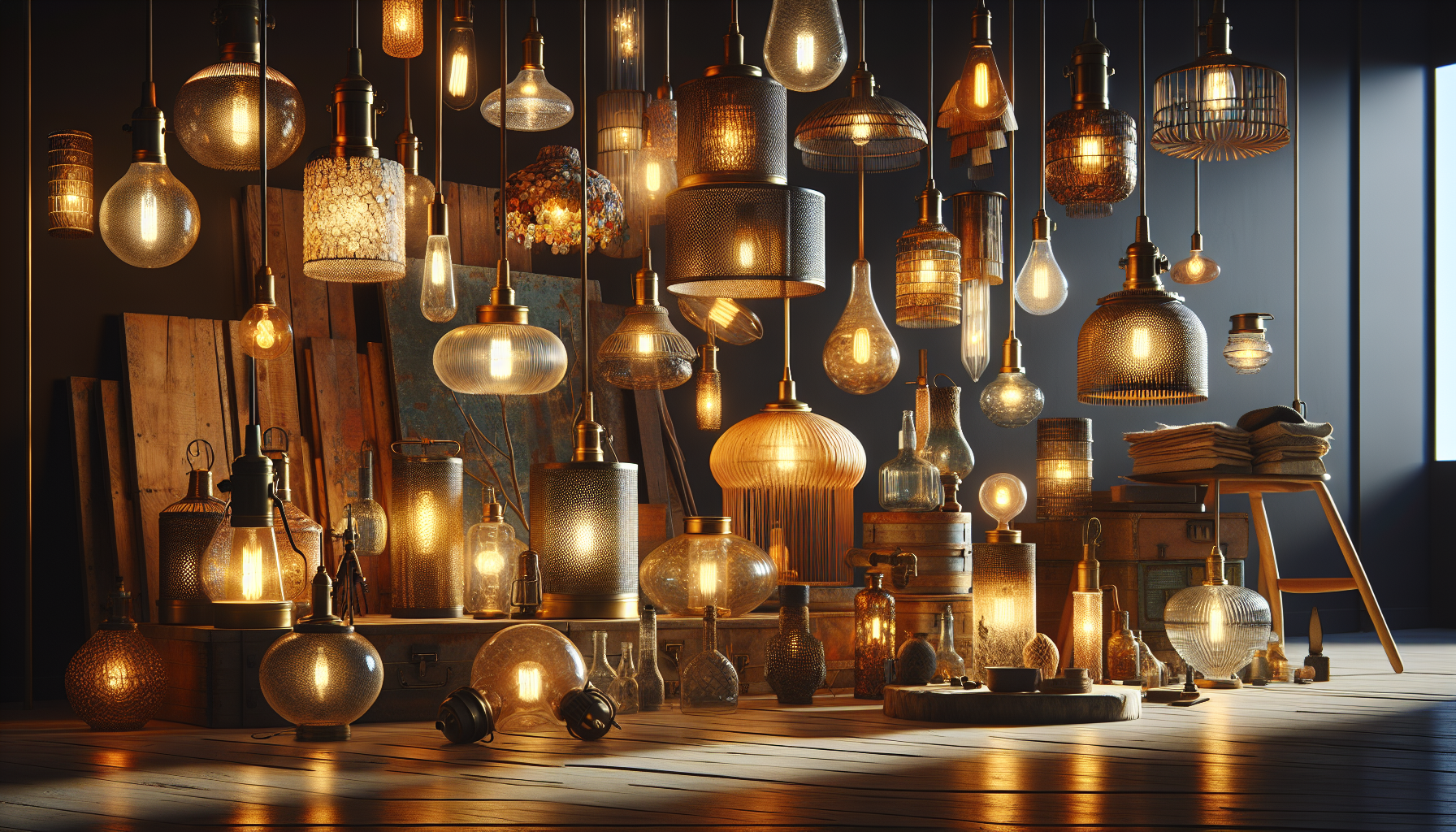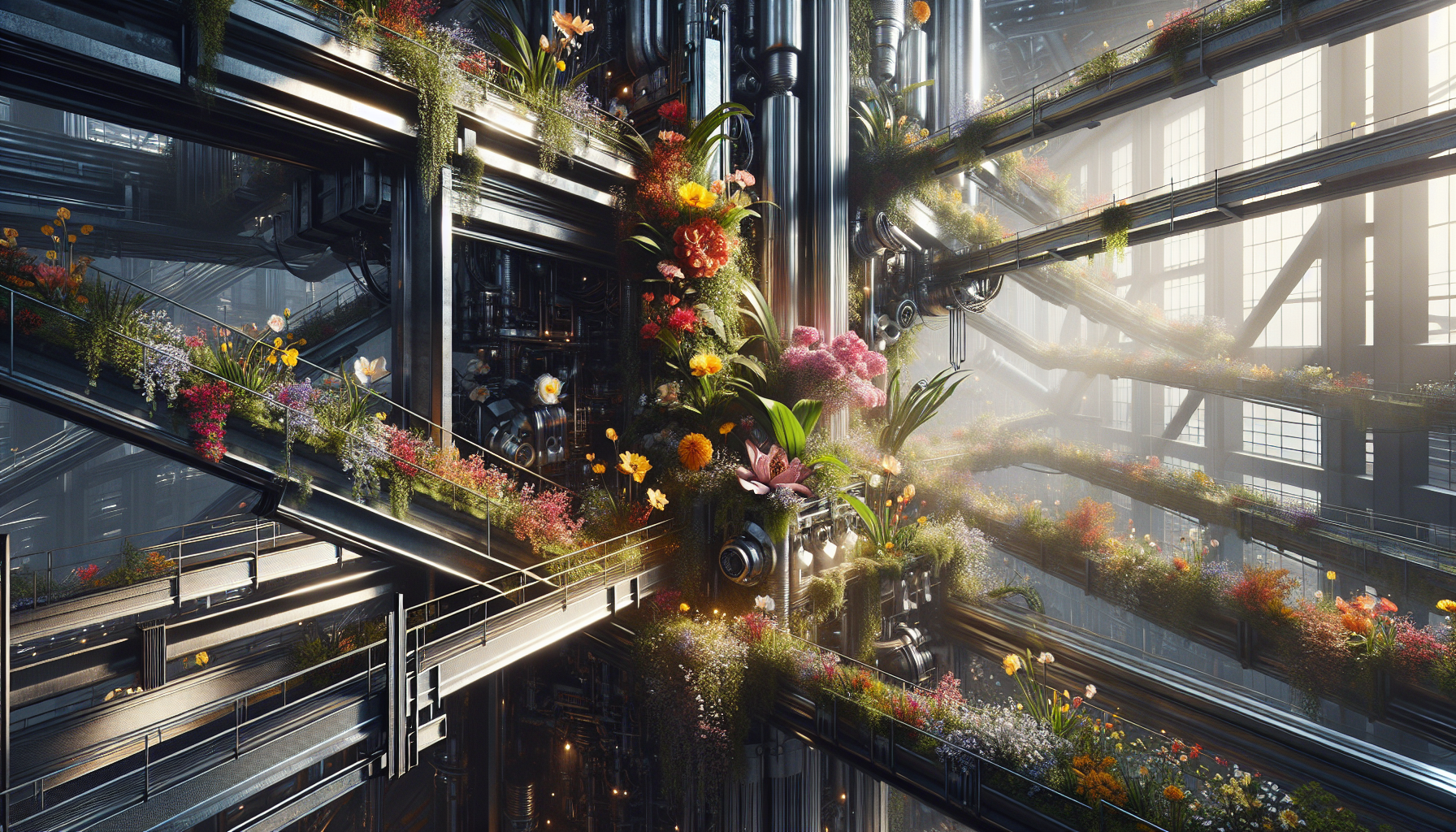Anúncios
In a world increasingly conscious of its ecological footprint, the art of transforming waste into something beautiful and functional has never been more pertinent or inspiring. Welcome to the captivating journey of reclaiming what was once discarded and giving it a new lease on life—specifically through the lens of interior décor. “Illuminate Your Space with The Reclaimed Glow: Transforming Waste into Radiant Decor” invites you to explore the enchanting possibilities of upcycled lighting solutions, where sustainability meets aesthetic brilliance. Imagine turning the mundane into the magnificent, the forgotten into the fabulous, and the overlooked into the outstanding—all with the flick of a switch and the glow of creativity.
The concept of upcycling has gained significant traction over the past decade, moving beyond a mere trend to become a pivotal part of contemporary design philosophy. This article will delve deep into the heart of this movement, focusing on how discarded materials—be they glass, metal, wood, or plastic—are ingeniously repurposed into lighting fixtures that do more than just illuminate a room. They tell a story, spark conversations, and serve as a testament to human ingenuity. We will explore the diverse range of materials that are commonly used in upcycled lighting projects, providing insight into the process of transforming waste into pieces of art that are as functional as they are decorative.
Anúncios
Throughout this exploration, we will shine a light on the work of innovative designers and craftsmen who are at the forefront of this sustainable revolution. From the urban chic of industrial-inspired pieces to the whimsical charm of nature-themed designs, you will discover a world where creativity knows no bounds. We will also offer practical tips for those eager to embark on their own upcycling adventures, whether you’re a seasoned DIY enthusiast or a curious beginner. By the end of this article, not only will you be inspired to rethink what you consider as waste, but you’ll also be equipped with the knowledge to transform it into a radiant centerpiece for your home. Let’s embark on this illuminating journey together and discover how the humble act of reimagining waste can lead to a brighter, more sustainable future. ✨
Understanding the Reclaimed Glow Concept
In recent years, the world has seen a significant shift towards sustainability and environmental consciousness. This transformation has permeated various aspects of our lives, including the way we decorate our spaces. One of the most innovative and impactful trends is the use of reclaimed materials to create radiant decor, a concept we refer to as “The Reclaimed Glow.” By transforming waste into stunning pieces of decor, we not only reduce environmental impact but also add a unique charm to our homes and offices. This approach combines creativity with responsibility, allowing us to enjoy beautiful spaces without compromising the health of our planet.
Anúncios
Reclaimed materials are essentially discarded items that are repurposed to serve a new function. This could include anything from old wood, metal, glass, or plastic that is given a new life as part of a lighting fixture or a decorative piece. The beauty of using reclaimed materials lies in their uniqueness; each piece carries a story and a history, making the decor not only aesthetically pleasing but also rich in character and narrative. This trend aligns perfectly with the growing appreciation for handcrafted and artisanal products, offering a bespoke touch to any interior design.
The environmental benefits of utilizing reclaimed materials are manifold. By repurposing waste, we reduce the demand for new raw materials, which in turn decreases the energy consumption and pollution associated with manufacturing processes. Additionally, it helps in reducing the volume of waste that ends up in landfills, promoting a circular economy where materials are continuously reused and recycled. This is particularly important in today’s world, where the effects of climate change and resource depletion are becoming increasingly evident. By choosing The Reclaimed Glow, individuals and businesses contribute positively to the environment while enjoying the aesthetic and functional benefits of innovative decor solutions.
Exploring Reclaimed Materials for Decor
When considering The Reclaimed Glow, it’s essential to understand the variety of materials that can be used in creating unique decor pieces. The most common materials include wood, metal, glass, and plastic, each offering distinct characteristics and benefits.
Wood is perhaps the most popular material used in reclaimed decor. Salvaged from old barns, factories, or shipping pallets, reclaimed wood offers a rustic and warm aesthetic that is highly sought after in modern interior design. Its natural texture and weathered appearance add depth and character to any space. Moreover, wood is incredibly versatile and can be used in various applications, from light fixtures to wall panels and furniture.
Metal is another excellent option for reclaimed decor. Old pipes, industrial machinery parts, and metal sheets can be transformed into stunning lighting fixtures or decorative accents. Metal’s durability and sleek appearance make it an ideal choice for both contemporary and industrial-style interiors. Furthermore, metal’s ability to be melted down and reshaped allows for endless creative possibilities.
Glass, particularly from old bottles or windows, can be repurposed into beautiful, one-of-a-kind decor pieces. The transparency and reflective properties of glass make it perfect for creating ambient lighting effects, adding elegance and sophistication to any room. Additionally, using reclaimed glass helps reduce the environmental impact of glass production, which is an energy-intensive process.
Plastic, often considered a less desirable material, can also be creatively reused in decor. By repurposing plastic waste, such as bottles or packaging, we can create vibrant and colorful pieces that add a playful touch to interiors. This approach not only reduces plastic pollution but also highlights the potential of this ubiquitous material when used innovatively.
Table: Comparison of Reclaimed Materials
Below is a table that compares the characteristics and benefits of different reclaimed materials used in decor:
| Material | Characteristics | Benefits | Applications |
|---|---|---|---|
| Wood | Natural, rustic, warm | Sustainable, versatile, adds character | Light fixtures, furniture, wall panels |
| Metal | Sleek, durable, industrial | Durable, recyclable, modern aesthetic | Lighting fixtures, decorative accents |
| Glass | Transparent, reflective, elegant | Reduces energy consumption, sophisticated | Ambient lighting, decor pieces |
| Plastic | Colorful, flexible, lightweight | Reduces pollution, versatile | Decorative items, creative designs |
The Process of Transforming Waste into Decor
The journey from waste to decor involves several steps, each crucial in ensuring the final product is both aesthetically pleasing and environmentally responsible. This process not only highlights the creativity involved in designing reclaimed pieces but also underscores the importance of sustainability in decor manufacturing.
The first step in this process is sourcing materials. This involves identifying and collecting waste materials that can be repurposed for decor. These materials are often sourced from demolition sites, industrial areas, or recycling centers. The key here is to choose materials that are in good condition and possess potential for creative transformation. This step often involves collaboration with local businesses and waste management facilities, fostering a community-focused approach to sustainability.
Once the materials are sourced, they undergo a thorough cleaning and preparation process. This is essential to ensure that the materials are safe and suitable for use in decor. For wood, this might involve sanding and treating the surface to prevent rot and pests. Metal pieces may require rust removal and polishing, while glass and plastic need to be washed and sometimes reshaped. This stage is crucial as it ensures the longevity and quality of the final product.
After preparation, the creative phase begins. Designers and artisans work on transforming the raw materials into beautiful decor pieces. This involves cutting, assembling, and finishing the materials to create unique and functional items. The creative possibilities are endless, with designers often drawing inspiration from the materials themselves. The goal is to highlight the natural beauty and history of the materials while creating a cohesive and stylish piece.
Video: Crafting with Reclaimed Materials
For a closer look at how reclaimed materials are transformed into decor, watch the video below:
“Crafting with Reclaimed Materials” – DIY Creators
Quality Control and Sustainability
Quality control is a critical aspect of the process, ensuring that each piece meets high standards of craftsmanship and safety. This involves inspecting the final product for any defects and testing its durability and functionality. Quality control not only guarantees customer satisfaction but also reinforces the sustainability credentials of the reclaimed decor, as only the best pieces make it to the market.
Sustainability is at the heart of The Reclaimed Glow concept. By choosing to create and use decor made from reclaimed materials, we reduce our environmental footprint and promote a more sustainable way of living. This approach also encourages others to think differently about waste, seeing it not as a burden but as an opportunity for creativity and innovation. As more people embrace this mindset, we move closer to a more sustainable and harmonious relationship with our environment.
- Identify and collect suitable waste materials.
- Clean and prepare materials for use.
- Design and create unique decor pieces.
- Ensure quality control and sustainability.
Incorporating Reclaimed Glow into Your Space
Integrating The Reclaimed Glow into your home or office decor can be a rewarding and fulfilling experience. Not only do you contribute to environmental sustainability, but you also enhance your space with unique and personalized decor that reflects your values and style. Here are some practical tips and ideas for incorporating reclaimed decor into your interiors.
One of the easiest ways to start is by introducing small reclaimed decor items into your space. These could be simple light fixtures, decorative accents, or even furniture pieces that add a touch of character and history to your room. Start by assessing the existing decor and identifying areas where reclaimed items could complement or enhance the overall aesthetic. This gradual approach allows you to experiment with different styles and materials without overwhelming the space.
Another effective strategy is to use reclaimed decor as a focal point in your room. A statement piece, such as a large reclaimed wood dining table or an industrial-style metal chandelier, can instantly elevate the look of your space. These pieces not only serve a functional purpose but also become conversation starters, allowing you to share the story and significance behind your decor choices with guests and visitors.
For those looking to make a more significant impact, consider undertaking a DIY project using reclaimed materials. This could involve creating custom shelves from old wood planks or designing a unique wall art piece from recycled metal or glass. DIY projects not only allow for creative expression but also provide a deeper connection to your decor, as you invest time and effort into crafting something truly unique and meaningful.
Embracing The Reclaimed Glow is not just about aesthetics; it’s about adopting a mindset that values sustainability and creativity. By choosing to incorporate reclaimed decor into your space, you join a growing community of individuals and businesses committed to making a positive impact on the environment. As you explore the possibilities of reclaimed materials, you may find yourself inspired to further integrate sustainable practices into other areas of your life, fostering a more holistic approach to living sustainably and stylishly. 🌿

Conclusion
In conclusion, the journey through the world of transforming waste into radiant decor has been both enlightening and inspiring. Throughout this article, we delved into the innovative ways in which reclaimed materials can be utilized to create stunning and sustainable lighting solutions. By highlighting key examples and techniques, we’ve seen how creativity and environmental consciousness can come together to redefine interior design.
One of the primary themes explored was the environmental impact of waste and the urgent need for sustainable practices. Waste management remains a critical global challenge, and the creative reuse of materials offers a viable solution to mitigate this issue. By transforming discarded items into beautiful, functional decor, we not only reduce landfill waste but also decrease the demand for new raw materials. This approach aligns with the principles of a circular economy, which aims to keep resources in use for as long as possible, extracting maximum value before recovery and regeneration.
Another significant point discussed was the aesthetic and functional potential of reclaimed lighting. From rustic chandeliers made of repurposed wood to industrial-style lamps crafted from old pipes, the possibilities are endless. These pieces do more than just illuminate a space; they tell a story and add a unique character to any room. The charm of reclaimed glow lies in its ability to blend past and present, offering a timeless appeal that resonates with environmentally-conscious consumers and design enthusiasts alike.
Moreover, we explored various techniques and materials that can be employed in creating reclaimed lighting. Glass bottles, metal scraps, wooden pallets, and even textiles can be repurposed to construct distinctive lighting fixtures. These projects not only challenge conventional design norms but also encourage a hands-on approach, inviting individuals to engage directly with the materials and processes involved. By doing so, we foster a deeper appreciation for craftsmanship and sustainability.
The importance of community and collaboration was another key element discussed. Numerous artists, designers, and small businesses are championing the reclaimed glow movement, proving that collaborative efforts can lead to innovative solutions. These pioneers serve as beacons of change, inspiring others to think differently about waste and its potential. Their work underscores the power of community in driving sustainable practices forward.
Additionally, the economic benefits of embracing reclaimed decor cannot be overlooked. By opting for recycled materials, costs are often reduced, making sustainable design more accessible to a wider audience. This democratization of eco-friendly decor supports the idea that sustainability should not be a luxury but a standard practice available to all.
The future of interior design is undoubtedly leaning towards more sustainable practices, and reclaimed lighting is at the forefront of this shift. As consumers become increasingly aware of their environmental footprint, the demand for eco-friendly products continues to rise. By incorporating reclaimed materials into our living spaces, we not only contribute to a healthier planet but also pave the way for innovative design solutions that reflect our values.
In light of these discussions, it is crucial to recognize the role each of us plays in promoting sustainability. Whether you are a designer, a homeowner, or simply someone interested in making a positive impact, there are countless ways to get involved. Explore local markets, support artisans who use reclaimed materials, or try your hand at creating your own reclaimed glow project. The possibilities are limited only by your imagination.
We encourage you to take the insights gained from this article and apply them in your daily life. Share this knowledge with others, inspire conversations about sustainable design, and consider how you can integrate reclaimed elements into your own space. By doing so, you become part of a larger movement dedicated to transforming waste into wonder and lighting up our world in a responsible and beautiful way.
Feel free to comment on your own experiences with reclaimed decor or share this article with friends and family who might be inspired by the idea of transforming waste into radiant beauty. Together, we can illuminate not just our spaces but also our commitment to a more sustainable and vibrant future. 🌿💡
For more information and resources on sustainable design, you can visit Green Building Elements and Sustainable Decor. These platforms offer a wealth of knowledge and inspiration for anyone interested in pursuing a more eco-friendly lifestyle.
Thank you for joining us on this illuminating journey. Let’s continue to shine a light on sustainability and embrace the reclaimed glow in every corner of our lives.
Toni Santos is a lighting artisan and visual explorer who designs atmospheres, not just objects. With a refined sensitivity to form, reflection, and emotion, Toni’s work at Sordux is an ode to how light transforms space, feeling, and story.
Through his handcrafted creations — from artistic glass bottles to radiant lighting totems — Toni invites us to see light as more than function. To him, light is symbolic. It is memory, energy, and meaning in motion.
Drawing inspiration from modern minimalism, ancestral aesthetics, and organic shapes, Toni blends natural materials with ambient expression. His collections are not just decorative — they’re immersive experiences, each one crafted to awaken the senses and reconnect us to the spaces we inhabit.
As the mind behind Sordux, Toni curates a world where illumination becomes ritual, and where every design element — from the curvature of a bottle to the hue of a glow — speaks of intention and presence.
🔥 His vision shines through:
-
Designs that merge mood with form
-
Bottled light as symbolic storytelling
-
Sustainable aesthetics rooted in artistic function
Whether you’re a designer, a dreamer, or someone who understands that light is a language of its own, Toni invites you into a world where glow becomes meaning, and every beam is an invitation to feel.





